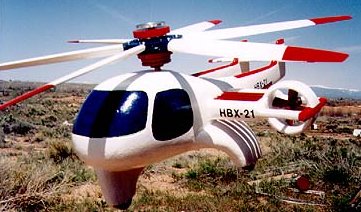Written and donated to the Helicopter History Site by the author
It was originally published in Helicopter World July edition 1999
As the use of helicopters in commercial operations (police, air ambulance, crop spraying, unmanned aerial vehicles, cattle mustering and game counting) increases without necessarily an increased budget, companies are looking for ways of getting the same service for less money, hence the growing interest in using small, economic ultralight helicopters where possible. The reasons for this are not only economic, they are also logistical; small helicopters tend to be nippier in their actions, turn more quickly and safely, are able to land in smaller areas, easily transportable by trailer if necessary as well as using up less hangar or parking space. The majority of ultralight companies whether producing kits or complete helicopters are interested in the commercial market and most ultralight helicopters have some characteristics that make them particularly attractive to potential buyers. There are, however, disadvantages in using smaller, lighter helicopters.
One is the reduced amount of weight it is possible to carry; therefore less spraying material for crop dusters, or fewer medicines and no patients in the case of Air Ambulance Helicopters. Another is a possible safety angle. Since ultralight helicopters have hardly been tested in commercial use there is very little knowledge of their limits. What those are may still be shown in the years to come.
This leads to a third problem; that of certification. In many countries it is only possible to get certification for private use of ultralight helicopters and while this may be sufficient for example, for cattle herding on private properties in Australia, it is severely restricting for the police or air ambulance associations. However, there are places where all these disadvantages have been overcome and the ultralight helicopter is already working in a commercial manner.
Baby Belle:
Created in Canada as a kit by Canadian Home Rotors Inc. the two seat Baby Belle
has evolved from the single seat Helicom designed in 1953, and is the result of more than 40 years of designing, testing and modifying.
The Baby Bell in its present form has a large, strong body 29 feet 8 inches long and 8 feet high with a rotor diameter of 25 feet. It is based on the Bell 47 and has an option to use the Bell 47 bubble canopy in building. It cruises at 85 mph and weighs 1450 lbs, which is more than the Robinson R22 , and its blade system is heavy so that autorotations are slower and easier than either the R22 or the Schweitzer 300 ; a safety angle which is highly important in commercial work. One advantage of the Baby Belle, in terms of getting commercial certification, is its decision to run on a certified Lycoming engine, something important for aviation authorities dubious of the rotax engines used by the majority of ultralight helicopters.
Present commercial uses include helping the police in Canada when their own helicopter is busy. On one occasion the police had to pass a message to a trapper deep in the bush, whose wife was seriously ill in hospital. Pilot Mark Richards flew out to the bush, inspite of quite poor weather conditions and a temperature of -14F (the Baby Belle was developed to withstand temperatures from +100F to -40F) to let a message down from the Baby Belle s cargo h ook. He then picked up the trapper and took him to an area where he could arrange transport to his sick wife.
On another occasion the Baby Belle was used as part of a team helping the fire brigade rescue casualties from a crashed plane in Mentone. Here the Baby Belle hovered over the crash site while relaying messages to the ground crew and Air Ambulance.
For the future Baby Belle are trying to get certification for commercial use in cattle mustering in Australia, which is currently only allowed by private owners on private land.
The Baby Bell in its present form has a large, strong body 29 feet 8 inches long and 8 feet high with a rotor diameter of 25 feet. It is based on the Bell 47 and has an option to use the Bell 47 bubble canopy in building. It cruises at 85 mph and weighs 1450 lbs, which is more than the Robinson R22 , and its blade system is heavy so that autorotations are slower and easier than either the R22 or the Schweitzer 300 ; a safety angle which is highly important in commercial work. One advantage of the Baby Belle, in terms of getting commercial certification, is its decision to run on a certified Lycoming engine, something important for aviation authorities dubious of the rotax engines used by the majority of ultralight helicopters.
Present commercial uses include helping the police in Canada when their own helicopter is busy. On one occasion the police had to pass a message to a trapper deep in the bush, whose wife was seriously ill in hospital. Pilot Mark Richards flew out to the bush, inspite of quite poor weather conditions and a temperature of -14F (the Baby Belle was developed to withstand temperatures from +100F to -40F) to let a message down from the Baby Belle s cargo h ook. He then picked up the trapper and took him to an area where he could arrange transport to his sick wife.
On another occasion the Baby Belle was used as part of a team helping the fire brigade rescue casualties from a crashed plane in Mentone. Here the Baby Belle hovered over the crash site while relaying messages to the ground crew and Air Ambulance.
For the future Baby Belle are trying to get certification for commercial use in cattle mustering in Australia, which is currently only allowed by private owners on private land.
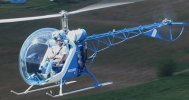
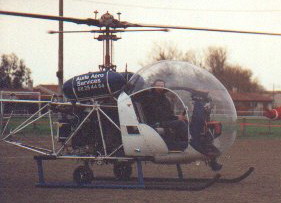
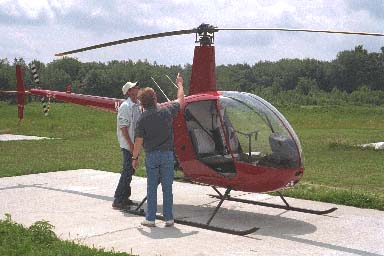
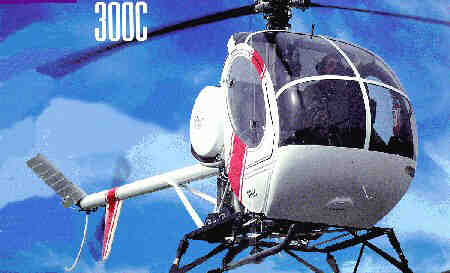
Eagle s Perch:
The Eagle's Perch is a twin engine, coaxial pendulum kit helicopter designed by brothers Herb and Jack Nolan from Jacksonville Florida, who decided on the twin engine, no tail-rotor idea for safety. It uses two Hirth 65 shp engines, which give it a cruise speed of 70-80 mph. A strong rugged helicopter weighing 1200lbs, it is 8 foot 1 in in height and 15.25 long, with a surprisingly short rotor blade diameter of 14 feet 5 inches. " We started out, " says Jack, " with rotors about 19 feet long. This is the sixth set of blades we ve built and every time we made them shorter, and every time it worked better. "
The brothers used the KISS (keep-it-simple-stupid) principal, which allow many of the parts to be replaced from an automobile replacement store: something important for those working out in the field.
The brothers used the KISS (keep-it-simple-stupid) principal, which allow many of the parts to be replaced from an automobile replacement store: something important for those working out in the field.
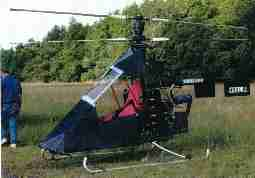
In 1995 the Eagle s Perch company built a sprayer for the helicopter to demonstrate, as they put it, "for our foreign customers the potential use of the Eagle s Perch in precision farming. " However this was not the only commercial use for the Eagle s Perch they had in mind. Easily converted to an unmanned aerial vehicle the brothers envisage the use of the helicopter as monitoring hazardous waste, searching for crashed helicopters, oil pipe line inspection, mustering cattle, and police work such observing traffic and terrorist activity.
Having no tail rotor gives the Eagle s Perch several advantages, for example when mustering cattle there is no chance of animals jumping into the tail rotor since there is only a rudder at the blind end of the helicopter. It also reduces maintenance.
Disadvantages of the Eagle s Perch are that although it can maintain flight on a single engine it cannot hover, though there is a ballistic parachute to provide an extra margin of safety.
Ultrasport:
In 1993 the Ultrasport 254 single seater made by American Sportscopter Inc completed its flight tests, its unique aspects included a roof suspended cyclic, a fenestron tail and its light empty weight of 252 lbs; hence its claim to be the only genuine FAA FAR Part 103 ultralight helicopter.
Since then the company has developed more versions of single and two seat kits all gradually becoming heavier and more robust. These now range from the original 254 with its 55 hp Hirth engine and all up weight of 525 lbs, to the two seat model 496, auw of 1085 lbs, which has a 95 hp Hirth engine giving a top speed of 65 mph, with an endurance of 2.25 hours. Unlike the 254 it has conventional floor connected cyclics.
Steve Ling of Light s American Sportscopter in Taiwan says models are being used for police traffic watching, agricultural spraying, fishing fleet observation and animal herding. There is some possibility that Ultrasport may have a future in police border patrol and UAV tactical applications but discussions on this are currently continuing.
The advantages of the Ultrasport is the fenestron tail which, like the Eagle s Perch rudder, will help protect animals from being hurt by the back end of the helicopter, and autorotations, which are very gentle thanks to the light body, long blades and very wide (8 foot) bow shaped skids, which bend and bounce back on landing. The disadvantage of the single seaters is such light helicopters might be more likely to suffer from the wind.
Since then the company has developed more versions of single and two seat kits all gradually becoming heavier and more robust. These now range from the original 254 with its 55 hp Hirth engine and all up weight of 525 lbs, to the two seat model 496, auw of 1085 lbs, which has a 95 hp Hirth engine giving a top speed of 65 mph, with an endurance of 2.25 hours. Unlike the 254 it has conventional floor connected cyclics.
Steve Ling of Light s American Sportscopter in Taiwan says models are being used for police traffic watching, agricultural spraying, fishing fleet observation and animal herding. There is some possibility that Ultrasport may have a future in police border patrol and UAV tactical applications but discussions on this are currently continuing.
The advantages of the Ultrasport is the fenestron tail which, like the Eagle s Perch rudder, will help protect animals from being hurt by the back end of the helicopter, and autorotations, which are very gentle thanks to the light body, long blades and very wide (8 foot) bow shaped skids, which bend and bounce back on landing. The disadvantage of the single seaters is such light helicopters might be more likely to suffer from the wind.
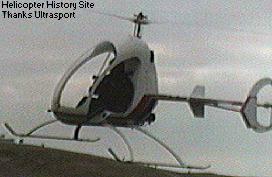
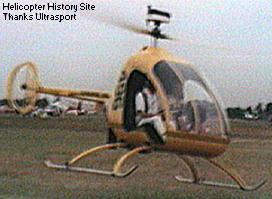
RotorWay 162F:
The RotorWay International company was originally started by the RotorWay Exec inventor BJ Shramm, then bought in 1990 by Yorkshireman John Netherwood , who ran it successfully for many years before the company was taken over in a recent management buy-out. The latest kit is the
162F benefiting from a FADEC engine system, which can be checked and maintained via a lap-top computer, something essential for those working out in the bush.
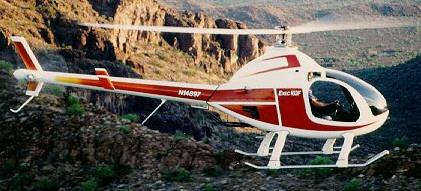
Like the Baby Belle this is a heavy machine for an ultralight weighing 1,500lbs. It is 28 feet 8 inches long and 8 foot high and cruises at 95 mph, with an endurance of 2 hours. Already in use in Nigeria for crop spraying, the Nigerian operator DANA (Dornier Aviation Nigeria AIEP Ltd.,) chose the 162F above certified helicopters because of its ability to run on MoGas as well as straight aviation fuel, which is in short supply in the countryside outside Kaduna. It is currently being used on a government project.
Cicare SVH-3 (Angel CH-7)
Designed as a basic trainer in Argentina by Augusto Cicare the Cicare SVH-3 is a cross between a tethered helicopter with wide skids and a simulator. It uses a full sized, single seat helicopter (based on the
Angel CH-7 created by the same designer with Marcello Gandini, famous for his Lamborghini bodies) attached to a hydraulically operated three dimensional base.
Like the Angel CH-7, the SVH-3 is a single seater, with a single 65 shp rotax engine, it weighs 1,078 lbs and has an endurance of 2.5 hours. Unlike the Angel it owes a large debt in training to its broad skids which are 11 foot in width; very good for accidental spinning landings. The hydraulic base is remotely operated by an instructor and both the helicopter and the base have a life of 4,000 hours.
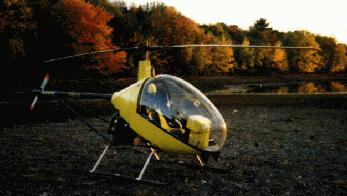
In May 1999, Augusto Cicare was awarded The Gold Medal for Excellence in the 27 Salon International des Inventions at Geneva , Switzerland in category "P" (aeronautical, nautical, vehicles and accessories) for the SVH-3. The competition included 1000 inventors from 45 countries. For commercial uses the Cicare Helicopteros Company is looking to speed up the basic training of military and police pilots as well as civilian school s, some of whom are already using the trainer.
Talon or Mini 500: Built by Revolution Helicopters the Talon, (the most recent version of the
Mini 500 ) is a rotax powered, single seater, (there is now a two seat trainer the Voyager 500.) Like the Eagle s Perch the Talon is 8 ft 1 ins high but is much lighter at 975 lbs auw. It has a cruise speed of around 85 mph with an unusually long endurance for an ultralight helicopter of 3 hours, which could have a commercial advantage in long distance work.
The police force in Missouri have used the Mini 500 for surveillance work, monitoring and other enforcement duties, but they never actually owned a helicopter, preferring instead to use the factory model when necessary.
The Mini 500 is currently under review for unmanned vehicle use by the military, who have their own certification processes and so are immune to civil aviation restrictions, it is being considered as a flying drone carrying monitoring equipment.
The Mini 500 is currently under review for unmanned vehicle use by the military, who have their own certification processes and so are immune to civil aviation restrictions, it is being considered as a flying drone carrying monitoring equipment.
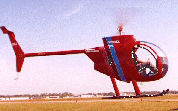
Intora Firebird:
Rather different from any of these helicopters is the Intora-Firebird, which uses little rockets on the blade tips, as well as an optional pusher engine extending the range to 6 hours of flight.
The rockets are powered with fuel which is 85% hydrogen peroxide, fed under pressure to jets on each rotor and generates about 100hp.
Flying is simpler than a helicopter since there is just one control "the monotrol" (a control column) with a twist-grip throttle, which has full directional authority.
Built with an eye on the unmanned aerial vehicle market there are two versions of the Firebird,
one is flyable the other is radio controlled from the ground.
Discussions are continuing with military and law enforcement agencies about future roles for the Firebird.
For the future there are several new ultralight helicopters (both kits and assembled helicopters) not yet on the market but soon to go into production , such as the
Masquito M80 and the Hummingbird HBX-21
, which seems to indicate that manufacturers have faith the potential of ultralights.
Undoubtably whatever the drawbacks of using these helicopters, ways around them will be found. This may mean that ultralights will be used in a supporting rather than unique role, as for example in the Baby Belle helping the police, or the Dragon Fly as a support system for the regular Czech Air Ambulance.
But, whether as a main player or a supporter as long as they continue to be smaller and cheaper than conventional helicopters ultralights are here to stay in the commercial field.
Undoubtably whatever the drawbacks of using these helicopters, ways around them will be found. This may mean that ultralights will be used in a supporting rather than unique role, as for example in the Baby Belle helping the police, or the Dragon Fly as a support system for the regular Czech Air Ambulance.
But, whether as a main player or a supporter as long as they continue to be smaller and cheaper than conventional helicopters ultralights are here to stay in the commercial field.
